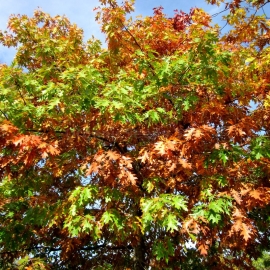





Organic Northern Red Oak Seeds (Quercus Rubra)
1.39 €
The Red Oak grows rapidly and is tolerant of many soils and varied situations. It is native to the north eastern United States and south eastern Canada. The tree gets its name from the leaves rich autumn colouring when they turn to a rich red color.
-
Organic Northern Red Oak (Quercus Rubra)
The Red Oak grows rapidly and is tolerant of many soils and varied situations. It is native to the north eastern United States and south eastern Canada. The tree gets its name from the leaves rich autumn colouring when they turn to a rich red and sometimes brown before falling.
Grown in a woodland setting it grows tall and straight generally up to 28m (90 ft), and exceptionally to 43m (140 ft) tall. When it is planted as an individual tree in an open situation it forms a narrow round-topped head with stout branches growing at right angles to the stem,
Best suited for medium loams and heavy soils including clay and even heavy clay soils but not waterlogged soils. Suitable for soils of wide ranging pH from acid to alkaline soils over limestone. It can grow in semi-shade (light woodland) or in full sunshine and can resist strong winds but not maritime exposure and is not suitable for coastal planting.
These seeds have been collected from several superb groups of specimen trees growing in the Limousin region of France during October 2012. Although these seeds have been collected from high quality ornamental specimens they have to be sold as 'not suitable for forestry purposes' to comply with current regulations.
How to Grow
Red Oak acorns have a shallow dormancy, if they are sown outside in late winter or early Spring the dormancy will be easily broken by the cold conditions naturally found within the soil. They can be sown outside in the garden usually during late February or March in soil that has been well cultivated and is free from weeds. Acorns can be broadcast over the soil or sown in drills and covered with a couple of centimeters of fine soil and will need protecting from mice, squirrels and pigeons etc. and intense frost
For seed that will be sown under glass the acorns should be mixed with a 50/50 blend of moist peat/compost and sharp sand -just enough to separate the seeds from each other. Put them in a plastic bag (freezer bags are ideal) and place the loosely tied bag in a fridge for at least 4 weeks. If they show signs of germination sow them immediately. After this period of pre-treatment they can be sown in good quality potting compost in deep containers (at least 20cm deep), covering each acorn with a couple of centimeters of soil
As soon as these seeds germinate they produce a very strong taproot, planting in shallow containers will cause severe root deformation. They can be started off under protection or indoors but should really be placed outside from the early summer. If you need to store your acorns before pre-treatment, mix them with slightly moist compost or peat and keep them in a cool place such as a frost free unheated outbuilding or in the fridge.
Initial growth is very rapid and within a few weeks from germination the seedlings will be between 10 and 20cm high. The trees will then rest for a few weeks before developing a terminal bud that will break into rapid new growth if the conditions are right. This usually brings height growth to 20 to 40cm. In warm locations and in favourable years the seedlings can even have a third growing phase of rapid growth before setting a resting winter bud. To encourage maximum growth ensure that the trees are never stressed because of a lack of water and that they are well nourished and grown in a warm, sunny position.
Trees should be planted in their permanent position as soon as is practical. If they are large enough, at the end of their first growing season and certainly at the end of the second. Allowing them to be grown in too shallow a container for any length of time will cause permanent root deformities that can lead to the failure of the tree once it grows to a large stature. Remember that Red Oak is pretty fast growing and will become very large and responds poorly to attempts to control its size by pruning.
